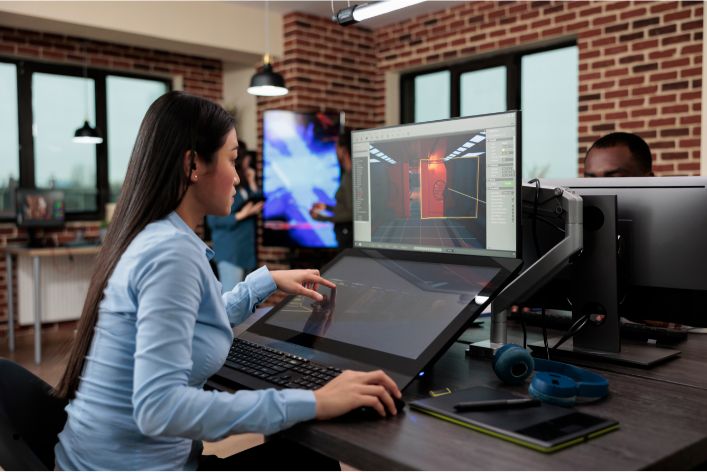Introduction
Imagine your life without modern software.
No smartphones, no online banking, no social media.
Life would feel vastly different. Bill Gates once said, “Software is a great combination between artistry and engineering”.
This quote highlights how software shapes our daily experiences.
Thesis Statement
This blog post explores the evolution of software.
We’ll journey from its early days to the sophisticated apps we use today.
Understanding this evolution helps us appreciate our current technologies.
It also allows us to anticipate future trends.
Purpose of the Post
Knowing the history of software evolution serves multiple purposes:
- Appreciation: By understanding software’s roots, we appreciate the complex systems we use daily.
- Insight: We gain insights into the development process and the challenges overcome by early pioneers.
- Future Trends: By studying the past, we can better predict and prepare for future technological advancements.
Why Understanding Software Evolution is Crucial
Appreciation of Current Technologies
Modern software makes our lives easier and more efficient.
From communication to transportation, software underpins many aspects of our daily routines.
Appreciating the journey helps us understand the significance of these innovations.
Anticipating Future Trends
The past often informs the future.
By understanding the trajectory of software development, we can better anticipate upcoming trends.
This knowledge prepares us for new technologies and the changes they bring.
Encouraging Innovation
Understanding software’s history inspires innovation.
Knowing the challenges and solutions of the past can spark new ideas.
Innovators can build on past successes and failures to create better solutions.
Practical Applications
- Educators: Can use this knowledge to teach students the importance of software in modern life.
- Developers: Gain inspiration and insight from historical advancements and apply them to current projects.
- Consumers: Understand and appreciate the tools they use daily, fostering a greater respect for technology.
Software evolution is a fascinating journey from simple programs to complex applications.
By understanding this evolution, we gain appreciation, anticipate future trends, and encourage innovation.
This blog post aims to provide a comprehensive overview of this journey, offering valuable insights into the world of software development.
Section 1: The Birth of Software
Early Concepts and Theories
Software’s journey begins with visionary thinkers.
Alan Turing and Charles Babbage paved the way for computational theories.
Turing proposed the concept of a universal machine, capable of performing any computation.
Babbage designed the Analytical Engine, an early mechanical computer.
These foundational ideas set the stage for software development.
First Generation of Software
The first generation of software emerged in the mid-20th century.
These programs were basic but revolutionary.
Early software programs included simple calculations and data processing tasks.
Assembly language was one of the earliest programming languages.
It allowed programmers to write instructions that the computer’s hardware could execute directly.
FORTRAN, another early language, made complex mathematical calculations possible.
It became the standard for scientific computing.
Key Milestones
The development of operating systems marked a significant milestone in software history.
Early computers ran a single program at a time.
Put Your Tech Company on the Map!
Get featured on Nicholas Idoko’s Blog for just $50. Showcase your business, boost credibility, and reach a growing audience eager for tech solutions.
Publish NowThere was no system to manage multiple tasks or users.
This changed with the advent of the first operating systems.
Development of the First Operating Systems
- GM-NAA I/O: Developed in the early 1950s, it was one of the first operating systems.
- IBM’s OS/360: Introduced in the 1960s, it supported a wide range of applications and hardware configurations.
These early operating systems allowed computers to perform multiple tasks simultaneously.
They managed hardware resources efficiently and provided a foundation for future advancements.
Introduction of Early Applications in Business and Science
Early software found its initial applications in business and scientific fields.
Businesses used software for accounting, payroll, and inventory management.
These applications automated repetitive tasks, saving time and reducing errors.
Examples of Early Business Software
- SABRE: An airline reservation system developed in the 1960s.
- LEO I: The first business computer used for commercial purposes.
Scientific research also benefited greatly from early software.
Programs for data analysis, simulations, and complex calculations became essential tools for scientists.
Examples of Early Scientific Software
- FORTRAN Programs: Enabled scientists to perform complex mathematical computations.
- Weather Prediction Models: Early software helped in developing models for weather forecasting.
These early applications demonstrated software’s potential to transform industries.
Challenges and Limitations
Early software faced significant challenges.
Memory and processing power were extremely limited.
Programmers had to write efficient code to maximize these scarce resources.
Debugging was a labor-intensive process, often done manually.
Despite these limitations, early software laid the groundwork for future innovations.
Legacy and Impact
The birth of software set the stage for exponential growth in computing.
The early theories and programs provided a blueprint for subsequent generations.
They demonstrated that software could solve complex problems and automate tasks.
This era established fundamental principles still relevant today.
The birth of software represents a critical period in technological history.
Early concepts and theories by visionaries like Turing and Babbage paved the way.
The first generation of software programs and operating systems marked significant milestones.
They demonstrated software’s potential in business and science.
Despite facing numerous challenges, early software developers laid the foundation for the sophisticated applications we use today.
Understanding this history helps us appreciate the complex systems that shape our modern world.

Section 2: The Rise of Personal Computing
1970s to 1980s: The Advent of Personal Computers
The 1970s and 1980s marked the rise of personal computers.
These machines revolutionized software development.
Personal computers brought computing power to individuals, not just businesses and governments.
This era saw the emergence of key players like Apple and Microsoft.
Their contributions significantly shaped the software landscape.
Impact of Personal Computers on Software Development
Personal computers allowed developers to experiment and innovate.
Software development became more accessible.
More people could write and test their programs on personal machines.
This democratization of computing sparked a software boom.
Key Players and Their Contributions
- Apple: Released the Apple II in 1977, which became widely popular.
- Microsoft: Developed MS-DOS in 1981, setting the stage for Windows.
These companies made personal computing mainstream.
Put Your Tech Company on the Map!
Get featured on Nicholas Idoko’s Blog for just $50. Showcase your business, boost credibility, and reach a growing audience eager for tech solutions.
Publish NowTheir products provided a platform for software developers to create innovative applications.
Software Becomes User-Friendly
The 1980s saw software become more user-friendly.
Graphical user interfaces (GUIs) emerged, making computers easier to use.
GUIs replaced text-based commands with visual elements like icons and menus.
Emergence of Graphical User Interfaces (GUIs)
- Apple Macintosh: Introduced in 1984, it featured a user-friendly GUI.
- Microsoft Windows: Launched in 1985, it brought GUIs to a broader audience.
These interfaces made computers accessible to non-technical users.
People could interact with software more intuitively, without needing to learn complex commands.
Popular Software Applications of the Era
Personal computers gave rise to popular software applications.
Word processors and spreadsheets became essential tools for both personal and professional use.
Examples of Popular Software Applications
- Word Processors: Applications like WordPerfect and Microsoft Word revolutionized document creation.
- Spreadsheets: Programs like VisiCalc and Lotus 1-2-3 transformed data analysis and management.
These applications increased productivity and streamlined tasks.
They demonstrated the potential of personal computing to enhance daily activities.
Programming Languages and Development Tools
The rise of personal computing also influenced programming languages and development tools.
New languages emerged, offering more power and flexibility.
Integrated development environments (IDEs) provided developers with comprehensive tools to write, test, and debug code.
Evolution of Programming Languages
- C: Developed in the early 1970s, it became widely used for system programming.
- BASIC: Simple and easy to learn, it introduced many to programming.
- Pascal: Known for its strong structure, it was popular in education and early software development.
These languages made programming more accessible and efficient.
They allowed developers to create more complex and powerful software.
Introduction of Integrated Development Environments (IDEs)
- Turbo Pascal: Released in 1983, it integrated an editor, compiler, and debugger.
- Microsoft Visual Studio: Launched in 1997, it provided a comprehensive development environment.
IDEs streamlined the development process.
They provided all the necessary tools in one package, making it easier to develop, test, and debug software.
The rise of personal computing in the 1970s and 1980s marked a pivotal era in software evolution.
Personal computers made computing power accessible to individuals, spurring innovation.
Key players like Apple and Microsoft played crucial roles in this transformation.
The emergence of GUIs made software user-friendly and accessible to non-technical users.
Popular applications like word processors and spreadsheets demonstrated the potential of personal computing.
The evolution of programming languages and the introduction of IDEs further advanced software development.
This period laid the foundation for the sophisticated and user-friendly software we rely on today.
Understanding this era helps us appreciate the rapid advancements that have shaped modern computing.
Section 3: The Internet and Open Source Revolution
1990s: The Internet Boom
The 1990s witnessed a transformative period for software development.
The internet revolutionized how we create and distribute software.
This era saw the birth of the World Wide Web, making information accessible globally.
Developers could now share their work and collaborate in unprecedented ways.
How the Internet Transformed Software Development and Distribution
The internet enabled rapid sharing of software and updates.
Developers could distribute software globally without physical media.
This shift reduced distribution costs and expanded the reach of software products.
Online forums and communities allowed developers to share knowledge and collaborate on projects.
Rise of Web Browsers and Early Web Applications
Web browsers became the gateway to the internet.
They allowed users to access and interact with web pages.
Put Your Tech Company on the Map!
Get featured on Nicholas Idoko’s Blog for just $50. Showcase your business, boost credibility, and reach a growing audience eager for tech solutions.
Publish NowThe first popular web browser, Mosaic, launched in 1993.
It laid the foundation for future browsers like Netscape and Internet Explorer.
- Mosaic: Introduced in 1993, it popularized web browsing.
- Netscape Navigator: Launched in 1994, it quickly became the dominant browser.
- Internet Explorer: Released by Microsoft in 1995, it competed with Netscape.
Early web applications emerged, providing interactive experiences online.
These applications ranged from email clients to online shopping platforms.
They demonstrated the potential of the web beyond static pages.
Open Source Movement
The 1990s also saw the rise of the open source movement.
Open source software became a cornerstone of modern development.
It allowed anyone to view, modify, and distribute the source code.
Definition and Significance of Open Source Software
Open source software is software with source code that anyone can inspect, modify, and enhance.
This approach fosters collaboration and innovation.
Developers can build on each other’s work, accelerating progress.
Open source projects benefit from diverse contributions and rapid iteration.
Major Open Source Projects
- Linux: An open source operating system kernel started by Linus Torvalds in 1991. It became the foundation for many operating systems.
- Apache HTTP Server: Launched in 1995, it became the most widely used web server software.
These projects showcased the power of open source collaboration.
They provided robust, reliable, and free alternatives to proprietary software.
Software Development Methodologies
The internet era introduced new methodologies for software development.
Agile and DevOps practices emerged, emphasizing flexibility, collaboration, and continuous improvement.
Introduction of Agile Practices
Agile methodology focuses on iterative development and customer feedback.
It values individuals and interactions over processes and tools. Agile practices include:
- Scrum: A framework for managing complex projects with regular, incremental improvements.
- Kanban: A visual system for managing work as it moves through a process.
These practices enable teams to adapt to changes and deliver value quickly.
Introduction of DevOps Practices
DevOps combines development and operations to improve collaboration and productivity.
It emphasizes automation, continuous integration, and continuous delivery. DevOps practices include:
- CI/CD: Continuous Integration and Continuous Delivery streamline code integration and deployment.
- Infrastructure as Code (IaC): Managing infrastructure through code to ensure consistency and scalability.
These methodologies enhance software quality and speed up the delivery process.
The internet and open source revolution of the 1990s fundamentally changed software development.
The internet enabled global distribution and collaboration.
Web browsers and early web applications expanded the web’s potential.
The open source movement fostered innovation through shared knowledge and collective effort.
New development methodologies like Agile and DevOps improved flexibility and efficiency.
Understanding this period highlights how connectivity and collaboration have driven software evolution.
This era’s advancements laid the groundwork for the dynamic and interconnected software landscape we navigate today.
Section 4: The Mobile and Cloud Era
2000s: Mobile Computing Revolution
The 2000s marked the beginning of the mobile computing revolution.
Smartphones and mobile apps transformed how we interact with technology.
They brought powerful computing capabilities to our fingertips, changing daily activities and business operations.
Emergence of Smartphones and Mobile Apps
Smartphones combined the functionality of computers with the convenience of mobile phones.
They allowed users to perform a wide range of tasks on the go.
Mobile apps became the primary way people interacted with their devices.
Put Your Tech Company on the Map!
Get featured on Nicholas Idoko’s Blog for just $50. Showcase your business, boost credibility, and reach a growing audience eager for tech solutions.
Publish Now- Apple’s iPhone: Released in 2007, it revolutionized the smartphone market with its user-friendly interface and app ecosystem.
- Google’s Android: Launched in 2008, it provided an open-source platform for a wide range of devices.
These platforms created vibrant ecosystems, encouraging developers to create innovative apps.
Key Platforms and Their Ecosystems
- iOS: Apple’s operating system for iPhones and iPads. It offers a seamless and secure user experience.
- Android: An open-source operating system by Google. It powers a diverse range of devices and fosters a large developer community.
These ecosystems include app stores, development tools, and user communities.
They provide resources and support for developers to create and distribute apps.
Cloud Computing and SaaS
The 2000s also saw the rise of cloud computing and Software as a Service (SaaS).
These technologies revolutionized how we store, access, and use software and data.
Definition and Benefits of Cloud Computing
Cloud computing involves delivering computing services over the internet.
These services include storage, processing, and networking.
- Flexibility: Users can scale resources up or down based on demand.
- Cost Efficiency: Cloud services reduce the need for physical hardware and maintenance.
- Accessibility: Users can access data and applications from anywhere with an internet connection.
Cloud computing provides a flexible and cost-effective way to manage IT resources.
Growth of Software as a Service (SaaS) Models
SaaS delivers software applications over the internet, eliminating the need for local installation.
- Accessibility: Users can access SaaS applications from any device with a web browser.
- Automatic Updates: Providers manage updates and maintenance, ensuring users always have the latest features.
- Subscription Model: SaaS typically uses a subscription model, offering flexibility and predictable costs.
SaaS has become a dominant software delivery model, supporting a wide range of applications.
Impact on Software Development and Distribution
Cloud computing and mobile platforms have significantly impacted software development and distribution.
They introduced new practices and expanded the reach of software applications.
Continuous Integration/Continuous Deployment (CI/CD)
CI/CD automates the process of integrating and deploying code changes.
It enables rapid development and frequent releases.
- Continuous Integration: Developers integrate code changes frequently, reducing integration issues.
- Continuous Deployment: Code changes automatically deploy to production, ensuring quick delivery of updates.
CI/CD enhances software quality and accelerates the development cycle.
Global Access and Scalability
Cloud computing and mobile apps provide global access and scalability.
- Global Access: Users can access applications and data from anywhere in the world.
- Scalability: Cloud services can handle increasing loads, supporting growing user bases and data volumes.
These capabilities ensure that software can meet the demands of a global audience.
The mobile and cloud era has revolutionized software development and usage.
Smartphones and mobile apps have made technology more accessible and versatile.
Key platforms like iOS and Android have created thriving ecosystems for innovation.
Cloud computing and SaaS offer flexible, cost-effective, and scalable solutions.
They have introduced new development practices like CI/CD and expanded global access to software.
Understanding this era highlights the ongoing transformation of the software landscape.
The advancements of the mobile and cloud era have set the stage for future innovations in technology.
Read: Impact of Internet: Transformation Through Software History
Section 5: Modern Software Trends
Artificial Intelligence and Machine Learning
Artificial intelligence (AI) and machine learning (ML) have become integral parts of modern software.
These technologies enable applications to learn and adapt without explicit programming.
AI and ML enhance software capabilities, making it smarter and more efficient.
Integration of AI in Modern Applications
Developers integrate AI into various applications to improve functionality and user experience.
AI algorithms analyze vast amounts of data to make predictions and decisions.
Machine learning models continuously learn from new data, refining their accuracy over time.
Examples of AI-Driven Software
- Recommendation Systems: Platforms like Netflix and Amazon use AI to suggest content and products based on user preferences.
- Virtual Assistants: Assistants like Siri, Alexa, and Google Assistant use AI to understand and respond to user queries.
- Chatbots: Many companies use AI-powered chatbots to provide customer service and support.
- Fraud Detection: Financial institutions use AI to detect and prevent fraudulent activities.
These examples demonstrate how AI enhances user experiences and operational efficiency.
Internet of Things (IoT)
The Internet of Things (IoT) represents the next frontier in software evolution.
IoT connects everyday objects to the internet, allowing them to communicate and interact.
This expansion of software into physical objects has transformative potential across industries.
Put Your Tech Company on the Map!
Get featured on Nicholas Idoko’s Blog for just $50. Showcase your business, boost credibility, and reach a growing audience eager for tech solutions.
Publish NowExpansion of Software into Everyday Objects
IoT devices collect and share data, enabling smarter decision-making.
They range from home appliances to industrial equipment.
By integrating software into these objects, we create interconnected systems that improve efficiency and convenience.
Applications of IoT in Various Industries
- Smart Homes: Devices like smart thermostats, lights, and security systems enhance home automation and energy efficiency.
- Healthcare: Wearable devices monitor vital signs and share data with healthcare providers for better patient care.
- Manufacturing: IoT sensors monitor equipment performance and predict maintenance needs, reducing downtime.
- Agriculture: Farmers use IoT devices to monitor soil conditions and optimize irrigation, improving crop yields.
These applications highlight IoT’s versatility and impact on multiple sectors.
Blockchain and Decentralized Applications
Blockchain technology has introduced a new paradigm in software development.
It provides a secure and transparent way to record transactions.
Decentralized applications (dApps) leverage blockchain to offer new solutions without a central authority.
Introduction to Blockchain Technology
Blockchain is a distributed ledger technology.
It records transactions in a secure and immutable way.
Each transaction adds a new “block” to the chain, creating a transparent and tamper-proof record.
Emerging Trends in Decentralized Applications (dApps)
- Cryptocurrencies: Bitcoin and Ethereum are the most well-known applications of blockchain technology.
- Smart Contracts: These self-executing contracts automatically enforce agreements based on predefined conditions.
- DeFi (Decentralized Finance): DeFi platforms offer financial services like lending and borrowing without traditional banks.
- NFTs (Non-Fungible Tokens): NFTs represent unique digital assets, transforming the art and entertainment industries.
These trends showcase blockchain’s potential to disrupt traditional systems and create new opportunities.
Modern software trends like AI, IoT, and blockchain are shaping the future of technology.
AI and ML enhance software capabilities, making applications smarter and more efficient.
IoT connects everyday objects, creating interconnected systems that improve various industries.
Blockchain introduces a secure and transparent way to record transactions, enabling decentralized applications.
Understanding these trends helps us appreciate the ongoing evolution of software.
These advancements are driving innovation and transforming how we interact with technology.
As these trends continue to evolve, they will shape the future of software and its applications.
Read: Software Solutions for Business Efficiency in High-End Markets

Section 6: The Future of Software Development
Predictions and Emerging Technologies
The future of software development promises exciting advancements.
Technologies like AI and quantum computing will revolutionize the industry.
Anticipated developments in AI include more sophisticated machine learning models and enhanced natural language processing.
These advancements will create more intuitive and efficient applications.
Anticipated Advancements in AI
- Enhanced Machine Learning: AI systems will learn and adapt faster, improving accuracy and efficiency.
- Advanced Natural Language Processing: Applications will understand and respond to human language more naturally.
- AI in Healthcare: AI will revolutionize diagnostics, personalized medicine, and patient care.
Quantum Computing
Quantum computing will break current limitations, solving problems beyond classical computers.
It will enable unprecedented processing power and speed.
Applications in cryptography, optimization, and complex simulations will benefit immensely.
- Cryptography: Quantum computing will enhance encryption methods, providing better security.
- Optimization: It will solve complex optimization problems in various fields, from logistics to finance.
- Simulations: Scientists will run complex simulations in chemistry, physics, and materials science more efficiently.
Challenges and Considerations
As technology advances, we must address ethical, security, and regulatory challenges.
Developers and policymakers must collaborate to navigate these issues responsibly.
Ethical Challenges
- Bias in AI: Ensuring AI systems are fair and unbiased is crucial.
- Privacy Concerns: Protecting user data in an increasingly connected world remains a priority.
Security Challenges
- Cybersecurity: As software complexity grows, so do the potential vulnerabilities. We must develop robust security measures.
- Quantum-Safe Cryptography: Preparing for the impact of quantum computing on current encryption standards is essential.
Regulatory Challenges
- Regulatory Compliance: New technologies must adhere to existing regulations while adapting to new ones.
- Global Standards: Establishing international standards for emerging technologies will promote consistency and security.
The Role of Developers and Innovators
Developers and innovators play a critical role in shaping the future of software.
Continuous learning and adaptation are essential in this fast-paced industry.
Importance of Continuous Learning and Adaptation
- Stay Updated: Keep up with the latest technologies and methodologies.
- Skill Development: Regularly update your skills to remain competitive in the job market.
- Industry Trends: Follow industry trends to anticipate future changes and opportunities.
Encouragement for Innovation and Creative Problem-Solving
Innovation drives progress in software development.
Developers should embrace creative problem-solving and think outside the box.
- Collaborate: Work with diverse teams to gain new perspectives.
- Experiment: Don’t be afraid to experiment with new ideas and approaches.
- Prototype: Develop prototypes to test and refine concepts before full implementation.
The future of software development holds immense potential.
Emerging technologies like AI and quantum computing will transform the industry.
However, we must address ethical, security, and regulatory challenges responsibly.
Put Your Tech Company on the Map!
Get featured on Nicholas Idoko’s Blog for just $50. Showcase your business, boost credibility, and reach a growing audience eager for tech solutions.
Publish NowDevelopers and innovators play a crucial role in this evolution.
Continuous learning and creative problem-solving are key to staying ahead.
By embracing these principles, we can shape a future where software continues to enhance our lives and solve complex problems.
Understanding and preparing for these changes ensures we remain at the forefront of technological innovation.
The future of software development is bright, and the journey ahead promises to be exciting and transformative.
Read: DevOps in Software Development: Revolutionizing Modern Practices
Conclusion
Recap of Key Points
Software has evolved significantly from its early days to modern applications.
Early computational theories laid the foundation.
Personal computers democratized software development.
The internet and open source movement revolutionized collaboration.
Mobile and cloud technologies transformed access and functionality. AI, IoT, and blockchain drive current innovations.
Final Thoughts
Understanding software history highlights the incredible progress we’ve made.
It shows how innovations build on each other.
Appreciating this journey helps us recognize the complexity and ingenuity behind today’s technologies.
It also prepares us for future advancements and challenges.
Call to Action
Explore and engage with modern software technologies.
Stay updated on emerging trends.
Learn new skills and embrace continuous improvement.
Collaborate with others to solve problems creatively.
Contribute to the development of innovative solutions.
By doing so, you can play a role in shaping the future of software.
Dive into coding, participate in open source projects, and experiment with new technologies.
Share your knowledge and experiences with the community.
Encourage others to join the journey of technological advancement.
Your efforts can drive progress and create a better future.
Engage with online courses, attend tech conferences, and join relevant forums.
Network with other professionals and exchange ideas.
Stay curious and open to learning new things.
The software industry thrives on innovation and collaboration.
By understanding the past and actively participating in the present, you can contribute to the future of software development.
The journey of software evolution is ongoing, and your involvement can make a difference.
Stay informed, stay involved, and keep pushing the boundaries of what’s possible.
The future of software is in your hands. Let’s shape it together.
Additional Resources
For Further Reading:
- The Evolution of Computing: From Mainframes to Personal Computers
- Disruptive Technology: How Businesses Are Adapting to AI, Blockchain, and IoT
- Open Source: Unleashing the Power of Collaboration for a Brighter Future
Before You Go…
Hey, thank you for reading this blog post to the end. I hope it was helpful. Let me tell you a little bit about Nicholas Idoko Technologies.
We help businesses and companies build an online presence by developing web, mobile, desktop, and blockchain applications.
Put Your Tech Company on the Map!
Get featured on Nicholas Idoko’s Blog for just $50. Showcase your business, boost credibility, and reach a growing audience eager for tech solutions.
Publish NowWe also help aspiring software developers and programmers learn the skills they need to have a successful career.
Take your first step to becoming a programming expert by joining our Learn To Code academy today!
Be sure to contact us if you need more information or have any questions! We are readily available.
[E-Books for Sale]
1,500 AI Applications for Next-Level Growth: Unleash the Potential for Wealth and Innovation
$5.38 • 1,500 AI Applications • 228 pages
Are you ready to tap into the power of Artificial Intelligence without the tech jargon and endless guesswork? This definitive e-book unlocks 1,500 real-world AI strategies that can help you.
See All 1,500 AI Applications of this E-Book
750 Lucrative Business Ideas: Your Ultimate Guide to Thriving in the U.S. Market
$49 • 750 Business Ideas • 109 pages
Unlock 750 profitable business ideas to transform your future. Discover the ultimate guide for aspiring entrepreneurs today!
See All 750 Business Ideas of this E-Book
500 Cutting-Edge Tech Startup Ideas for 2024 & 2025: Innovate, Create, Dominate
$19.99 • 500 Tech Startup Ideas • 62 pages
You will get inspired with 500 innovative tech startup ideas for 2024 and 2025, complete with concise descriptions to help you kickstart your entrepreneurial journey in AI, Blockchain, IoT, Fintech, and AR/VR.
We Design & Develop Websites, Android & iOS Apps
Looking to transform your digital presence? We specialize in creating stunning websites and powerful mobile apps for Android and iOS. Let us bring your vision to life with innovative, tailored solutions!
Get Started Today



